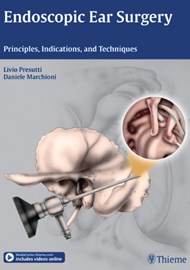I was delighted to be asked to review this book. It’s big and shiny, and has 400 pages, many of which bear beautiful colour images including endoscopic photographs, radiological images and clear illustrations of middle ear anatomy.
The preface to this book helpfully explains the philosophy of endoscopic ear surgery through the concept of functional surgery, i.e. maintaining the ear’s original anatomy and physiology where possible.
The opening chapter deals with problems that the beginner may encounter, such as learning to operate with only one hand, control of haemorrhage, and fogging of the endoscope. And of course, the benefits of endoscopic surgery are extolled, these being minimal access, anatomical preservation, and a wide field of view. I was drawn in, interested to find out whether this book would alter my perception that single-handed surgery with a monocular endoscope isn’t superior to double-handed surgery using a binocular microscope.
The second chapter carefully and clearly explains the principles of endoscopic ear surgery. The arguments for and against using the technique in cholesteatoma surgery are discussed, along with the fact that access to the mastoid cavity proper is approachable only via the traditional microscopic technique. Chapters follow on embryology, middle ear anatomy, pathophysiology and radiology. Further chapters offer the authors’ experiences in dealing with more advanced procedures including endoscopic stapes surgery, endoscopic management of middle ear neoplasia, and endoscopic approaches to the inner ear and petrous apex.
The wisdom within this book convinces me that the endoscope has a valuable role in ear surgery, as an adjunct as well as a primary approach. And, as the editors confess, this is only a starting point and certainly not a point of arrival. I’m giving the book 5/5 because it’d be a lovely addition to a hospital library or an otologist’s bookshelf.





